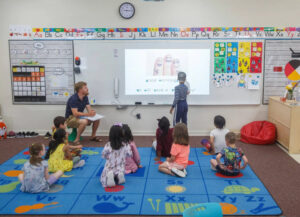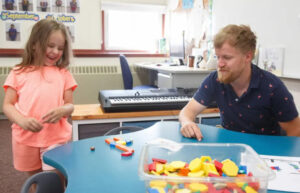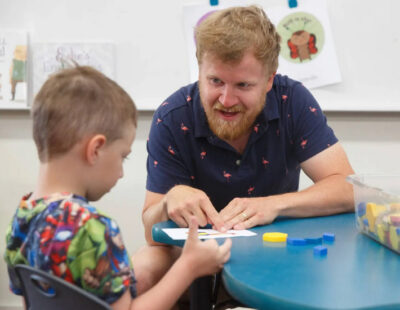Kenny Benson is one of a kind.
And while kids, their parents and his colleagues may, indeed, hold him in high esteem, his singularity is the product of an inescapable truth about elementary school teachers just about everywhere on the continent.
Benson, a man, is a kindergarten teacher at Winnipeg’s St. George School. In fact, since a former male colleague’s retirement several years ago — who jokingly referred to him as “the other one” — he’s the last man standing in a kindergarten class in the entire Louis Riel School Division.
“As the only male, I do think I have a responsibility to be more present in the building,” said Benson.
“I don’t stay in my room when I have chances to (get out). I’m out talking… at recess, in the hallways, talking to all the boys.”
There will be about a dozen kindergarten teachers who identify as men working in city public schools this year.
In the Winnipeg School Division, Manitoba’s largest, five of 89 kindergarten educators (just under six per cent) are men. In St. James-Assiniboia, there are none.
Teacher-training institutions have long recorded an overwhelming gender gap among applicants and graduates, although binary identifiers were recently phased out in the University of Manitoba’s education faculty.
Citing the “boy crisis,” concerns about everything from declining post-secondary enrolment rates to worrying school suspension and suicide figures within the demographic, researchers who study masculinity are questioning why there are minimal efforts to encourage men to pursue teaching careers.
U.S. author and scholar Richard Reeves, who founded the American Institute for Boys and Men this summer, has been among the loudest voices calling for a “massive, urgent recruitment effort” to bolster representation and lead the way for academic intervention.
In contrast, earlier this year the Winnipeg School Division deleted a policy that indicated it strives to reflect the composition of men within its schools where gender equality is an issue.
The decision was made in response to a newly released employment-equity audit that recommended the employer remove the reference because “there is no evidence that (men) experience systemic and persistent discrimination in the labour market.”
Given the education workforce is primarily female, men are over-represented in leadership roles across the sector in Manitoba.
It is noteworthy that men are often tapped for administrative positions and able to pursue those opportunities, said Cameron Hauseman, an assistant professor of educational administration at U of M.
Hauseman indicated misconceptions about poor pay, unfair beliefs that society holds about men who want to work with children and a lack of male role models in schools all discourage men from wanting to work at the front of a classroom.
“It’s entirely possible for students to go through kindergarten through Grade 8 and not have a male teacher at all,” said the academic and trained elementary school teacher. “Without targeted recruitment, I don’t see how we’re going to solve this problem.”
Hauseman noted the findings of Thomas Dee, now a professor at Stanford University’s Graduate School of Education, in his 2006 research paper entitled The Why Chromosome.
Dee analyzed student achievement in science, social studies and English, and concluded students who were taught by a teacher of the same sex performed better than their peers. “Simply put, girls have better educational outcomes when taught by women, and boys are better off when taught by men,” he wrote at the time.
While acknowledging the paper was controversial because it called co-educational schooling into question, Hauseman said it also highlighted just how important representation is in schools.
“It gives them a sense of what’s possible and without that, we end up with these disparities in achievement and engagement that we’re seeing right now — really across the board, with a number of groups,” he added.
Manitoba’s on-time graduation rate was 83 per cent in 2021-22, the most readily available data online. Among girls, that figure was 85 per cent. It was 81 per cent for boys.
The gender gap is wider — more than six percentage points — among students who identify as First Nations, Métis or Inuit.
Provincial assessment data show the only time boys are consistently outperforming their peers is in Grade 3 mathematics, and by the time all students get to Grade 7, average numeracy scores are on par.
Meanwhile, boys’ lagging literacy levels are failing to keep pace with their female peers.
Last year, the difference between the percentages of girls and boys achieving Grade 8-level expectations for reading and writing was 13 per cent and 18 per cent, respectively. When those cohorts’ literacy levels were tested five years earlier, the discrepancy was just under eight per cent.
“I recommend any parent or guardian to read daily to their very young children and encourage boys to read,” said Doug Gosse, an education professor at Nipissing University in North Bay, Ont.
A decade ago, Gosse sought to understand why boys often enter school and progress throughout levels with poorer reading and writing skills than their sisters.
It turns out parents and guardians read less to their sons than their daughters, and take girls to the library more often than they do boys, he said, noting the gendered expectations and activities that are ingrained in North American society.
Gosse said all children benefit from exposure to diverse reading materials, active lessons that especially humour boys’ energetic nature in contrast to restrictive seatwork and words of encouragement. Reading clubs and mentorship programs that ensure young boys mingle with older boys are incredibly impactful, he added.
Benson is hyper-aware of the gendered expectations of all of his children, both biological and those on his kindergarten-class list, and the reality that many do not have a father figure at home.
“We need to be more conscious of the different ways that we raise the children and even interact with them — not to remove gender from the equation, but (to recognize) our rewards system,” he said. “At a young age, we do tend to value different attributes in boys and girls.”
He said girls — his only daughter included — tend to get praised for being smart and tidy versus the reinforcements boys get related to being strong, fast and sporty, he said, adding he has never once heard one of his sons be called “pretty or handsome.”
“I make sure I’m wearing pink and purple in September,” he said. “I make a huge point of that and doing things that (challenge) gender norms because we do have boys who think they can’t play dollhouse.”
He is not exempt from blatant pre-judgments; he is used to being subject to a scoff or laughter after telling other dads what he does for a living while mingling with adults at a children’s birthday party.
Benson worked in a shipping-and-receiving warehouse after Grade 12. He entered teachers college later in life, after his now-wife noted he seemed to be happiest when coaching kids sports and working at summer camps.
As St. George’s only male classroom teacher, he said he is often called to the school door when young boys in any grade are experiencing “big emotions” and do not want to come inside.
“And they melt into my arms with a hug like I’m their dad, and I really think they weren’t going to come into the building until they saw me.”
In Boys: What It Means to Become a Man, journalist Rachel Giese argues there has been too little critique of the demands masculine stereotypes place on boys and questions the “pervasive belief” that women’s gains come at the expense of men.
“Perhaps the boy crisis isn’t about brain difference or an anti-male culture at schools. Perhaps ideas about school and masculinity are what’s causing boys to fail,” Giese wrote in her 2018 book in a chapter on academics.
The mother, who adopted an Anishinaabe son with her wife, discusses in-depth how the most vulnerable boys — with an emphasis on children from poor families and who are Black — are grappling far more than their peers who are white and from suburban, middle-class households.
A long-term study of North Carolina’s public schools found having at least one Black teacher in elementary school significantly increased the chances of a low-income Black student graduating high school and attending college, she noted.
Starting in 2020, Manitoba’s Newcomer Education Coalition and Winnipeg Indigenous Executive Circle started issuing annual reports to call attention to the urgent need to increase representation among teaching rosters.
The groups estimate upwards of 600 Indigenous teachers need to be hired across city school divisions in order to reflect the population of First Nations, Métis and Inuit pupils.
Ryan Cook has outfitted his vice-principal’s office with colourful student artwork, hockey pucks and printed-out lyrics from some of his favourite Indigenous artists.
Unreconciled, Wayi Wah! Indigenous Pedagogies and Resurgence are among the titles stacked on his bookcase. In one corner sits a massive drum — a sacred instrument he plans to use to launch a drum circle at Maples Collegiate this fall.
The Cree administrator, whose family hails from Misipawistik First Nation and Matheson Island, wants students to immediately know where he comes from and what he cares about most.
“All I do is come to work and just be myself,” Cook said. “That’s a breath of fresh air for (Indigenous teens) because they finally can sit down and see themselves and be like, ‘OK, I can relax here; he’s just like me.’”
In addition to the pressures on Indigenous boys to be tough and stoic, which may lead to getting involved in gangs and violence, the reality is their present is linked to the past, he said, noting the legacy of the residential school system and other colonial policies that have left enduring scars.
“If we look at anybody who’s extremely successful in school, it’s — 99 per cent of the time — because there’s so much support at home,” Cook said.
“And even though we have lots of Indigenous families who really value school and support their kids at home and things like that, we still also have a lot where that relationship and that support and those opportunities just aren’t there and that is why we see students struggling in school.”
He often works with First Nations students who fly into Winnipeg to complete high school, and does not shy away from having frank conversations about colonialism’s impact on his students, their families and social issues in their communities.
Cook also makes a point of ensuring every student knows they are in no rush to finish high school in four years.
The six-year graduation rate among Indigenous students in Manitoba was 63 per cent in 2022 — up 12 per cent from the on-time figure.
While the vice-principal said it is “more than 100 per cent” worthwhile to put effort into recruiting more male teachers, he said the numerous land-based learning teachers who are men in Indigenous communities should not be overlooked.
“We really have to look at what education is and analyze if we’re doing it any justice by excluding (activities outside a school, such as hunting and fishing),” he said.
Maggie Macintosh reports on education for the Winnipeg Free Press. Funding for the Free Press education reporter comes from the Government of Canada through the Local Journalism Initiative.
September 5, 2023

